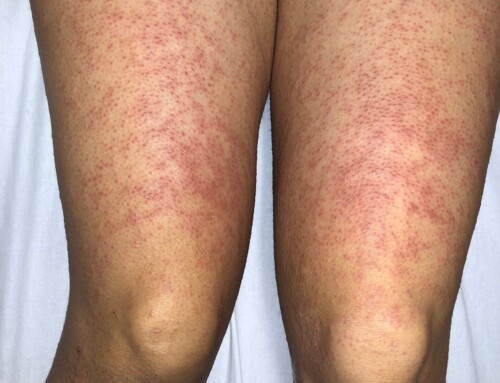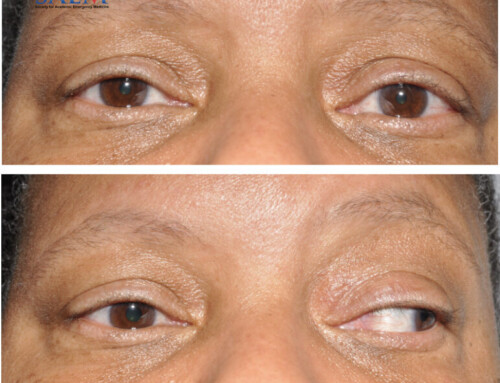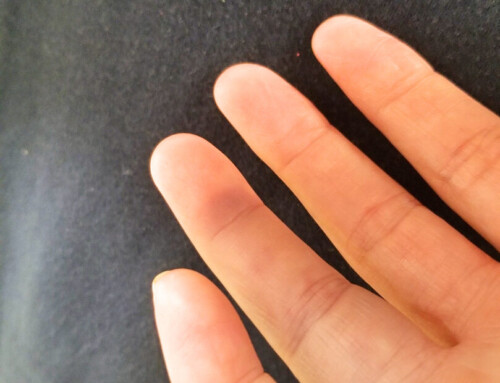
A 3-year-old female with a history of epilepsy presents with a rash that began one day ago. The patient started becoming fussy four days ago, saying, “I don’t feel good,” and not wanting to play outside with her siblings or finish her meals. Family noticed the patient rubbing her eyes frequently and crying when she went to the bathroom. She felt warm so they gave her Tylenol and Motrin at home. Yesterday, they noticed a rash was starting to develop with itchy, painful red spots. This morning, the rash progressed to involve some blisters on the face, chest, and back.
Medications include Tylenol, Motrin, and lamotrigine, which was started by her neurologist three weeks ago. Family history is significant for epilepsy on the father’s side of the family.
Vitals: BP 80/50; HR 152; RR 26; Oxygen Saturation 95%; Temperature 100.4°F
Constitutional: Tired-appearing child who cries when touched
HEENT: Bilateral conjunctival injection, and dry mucous membranes
Cardiovascular: Tachycardic with a regular rhythm
Pulmonary: Lungs are clear to auscultation bilaterally
Skin:
- Diffuse tender erythematous confluent maculopapular rash with vesicles, bullae, and erosions involving the mucous membranes of the mouth and genitalia
- Applying gentle lateral pressure to the skin results in sloughing of the epidermis
Abdomen: Soft, non-tender
Neurological: Normal tone and gait
The remainder of the exam is unremarkable
BMP:
- Potassium: 5.2 mmol/L
- Blood urea nitrogen (BUN): 25 mmol/L
- Creatinine (Cr): 1.2 mg/dL
Urine analysis:
- Specific gravity: 1.038
- Negative for infection
Electrocardiogram (EKG): Sinus tachycardia, and normal T waves
This child, who recently started taking lamotrigine, developed prodromal symptoms of fever, malaise, and myalgias, followed by a painful blistering rash. The exam reveals a febrile, tachycardic, hypotensive patient who appears dehydrated and displays a concerning Nikolsky positive rash involving ocular, oral, and genital mucosa. Labs show further evidence of volume depletion with a pre-renal acute kidney injury, concentrated urine, and hyperkalemia.
These findings are concerning for Stevens-Johnson syndrome/toxic epidermal necrolysis (SJS/TEN)
Two major leading causes of death include:
- Hypovolemia with electrolyte imbalance due to poor oral intake and insensible losses
- Infection with staphylococcal and pseudomonal species
SJS/TEN is a spectrum of epidermal detachment with systemic illness, where SJS involves < 10 percent of the body surface area and TEN involves >30 percent [1, 2]. Causes include medications (commonly antibiotics and anticonvulsants), infection (herpes simplex virus, human immunodeficiency virus), cancer, immunologic disease, and idiopathic etiologies.
Management should include: airway evaluation, as mucosal involvement can include sloughing of the respiratory epithelium; resuscitation with correction of electrolytes; temperature control; monitoring for signs of infection; dermatology and ophthalmology consults; and admission to a burn intensive care unit (ICU) if available. Ophthalmology should be consulted early as these patients are at risk for complications from corneal inflammation.
Diagnosis is supported by clinical findings and skin biopsy, and the likelihood of drug relation can be supported by the algorithm of drug causality for epidermal necrolysis (ALDEN) [3]. Illness severity scoring systems like Score of Toxic Epidermal Necrosis (SCORTEN) & ABCD-10 (asymmetry, border, color, diameter) can be used to better predict mortality in adults [4].
Take Home Points
- In patients with SJS/TEN, immediately resuscitate to correct hypovolemia and electrolyte abnormalities.
- Consult dermatology, ophthalmology, and burn teams early, with admission to a burn ICU if available.
- The ALDEN algorithm can help support the likelihood of drug reaction, while SCORTEN and ABCD-10 scores are used to predict mortality in adults.
- Sochor, M., Pandit, A. & Brady, W. J., 2016. Chapter 249: Generalized Skin Disorders. In: M. M. Judith E Tintinalli, ed. Tintinalli’s Emergency Medicine: A Comprehensive Study Guide. s.l.:McGraw-Hill Education, pp. 1642-1646.
- Harr T, French LE. Toxic epidermal necrolysis and Stevens-Johnson syndrome. Orphanet J Rare Dis. 2010;5:39. Published 2010 Dec 16. doi:10.1186/1750-1172-5-39 PMID: 21162721
- Sassolas, B. , Haddad, C. , Mockenhaupt, M. , Dunant, A. , Liss, Y. , Bork, K. , Haustein, U. F., Vieluf, D. , Roujeau, J. C. and Le Louet, H. (2010), ALDEN, an Algorithm for Assessment of Drug Causality in Stevens–Johnson Syndrome and Toxic Epidermal Necrolysis: Comparison With Case–Control Analysis. Clinical Pharmacology & Therapeutics, 88: 60-68. doi:10.1038/clpt.2009.252 PMID: 20375998
- Noe MH, Rosenbach M, Hubbard RA, et al. Development and Validation of a Risk Prediction Model for In-Hospital Mortality Among Patients With Stevens-Johnson Syndrome/Toxic Epidermal Necrolysis—ABCD-10. JAMA Dermatol. Published online March 06, 2019155(4):448–454. doi:10.1001/jamadermatol.2018.5605 PMID: 30840032
Copyright
Images and cases from the Society of Academic Emergency Medicine (SAEM) Clinical Images Exhibit at the 2020 SAEM Annual Meeting | Copyrighted by SAEM 2020 – all rights reserved. View other cases from this Clinical Image Series on ALiEM.

Amanda Gonzalez, MD
UT Southwestern Medical Center

Latest posts by Amanda Gonzalez, MD (see all)
- SAEM Clinical Image Series: Blisters, Bullae, and Badness - January 4, 2021

Cassandra Mackey, MD
Department of Emergency Medicine
University of Massachusetts

Latest posts by Cassandra Mackey, MD (see all)
- SAEM Clinical Images Series: Dermatology Deserving a Deeper Dive - January 2, 2023
- SAEM Clinical Images Series: A Rash You Don’t Want to Miss - November 28, 2022
- SAEM Clinical Image Series: Blisters, Bullae, and Badness - January 4, 2021

Larissa Velez, MD
Professor and Vice Chair for Education
Department of Emergency Medicine
UT Southwestern Medical Center

Latest posts by Larissa Velez, MD (see all)
- SAEM Clinical Image Series: Blisters, Bullae, and Badness - January 4, 2021

Fernando Benitez, MD
Department of Emergency Medicine
University of Texas Southwestern Medical Center

Latest posts by Fernando Benitez, MD (see all)
- SAEM Clinical Image Series: Blisters, Bullae, and Badness - January 4, 2021




